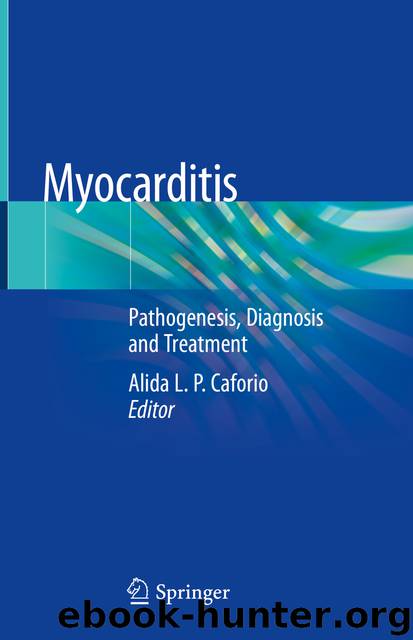Myocarditis by Alida L. P. Caforio

Author:Alida L. P. Caforio
Language: eng
Format: epub
ISBN: 9783030352769
Publisher: Springer International Publishing
10.6 Specific Aabs Tests as Organ-Specific Autoimmune Markers in Myocarditis/DCM
10.6.1 Anti-Heart Aabs (AHA) and Anti-Intercalated Disk Aabs (AIDA) by Standard Indirect Immunofluorescence (s-I IFL)
Using indirect s-I IFL on 4 μm-thick unfixed fresh frozen cryostat sections of blood group O normal human heart and skeletal muscle, and absorption with human heart and skeletal muscle and rat liver, organ-specific IgG AHA giving a diffuse cytoplasmic staining pattern of myocytes and a negative pattern on skeletal muscle (Fig. 10.1, panels a, b) were found in about 30–56% of myocarditis/DCM patients and their symptom-free family members, in 1–4% of patients with other cardiac disease, in 3% of normal subjects, and in 17% of patients without cardiac disease, but with autoimmune polyendocrinopathy (Table 10.2) [53, 68, 69, 79]. AHA of the cross-reactive 1 type, partially cardiac-specific by absorption, gave a fine striational staining pattern on myocytes, but were negative or weakly stained skeletal muscle (Fig. 10.1, panels c, d), and were also more frequently detected in DCM/myocarditis than in controls. On the other hand, AHA of the cross-reactive 2 type, entirely skeletal muscle cross-reactive by absorption, gave a broad striational “myasthenic” pattern on heart and skeletal muscle (Fig. 10.1, panels e, f), and were found in similar proportions among groups [53, 68, 69, 79]. Anti-intercalated disk aabs (AIDA), giving a linear staining on cardiomyocytes (Fig. 10.1, panel a), are associated with myocarditis/DCM and with idiopathic recurrent acute pericarditis [137].
Clinical and Diagnostic Role of AHA in Symptom-Free DCM Relatives
In autoimmune disorders, circulating aabs identify symptom-free subjects at risk years before clinical presentation. So far, the clinical and prognostic significance of cardiac aabs has been prospectively assessed only for AHA in symptom-free relatives of DCM index patients, not for the other published aabs shown in Table 10.2. In particular, healthy relatives of patients with DCM who have echocardiographic changes, including left ventricular enlargement (LVE) or depressed fractional shortening (dFS) at baseline, have increased medium-term risk for DCM development [142]. Approximately one-third of relatives from both familial and nonfamilial pedigrees have serum AHA at baseline [52]. AHA are independent predictors of DCM development in symptom-free relatives at 5 year follow-up [53] . In this study, baseline evaluation, including electrocardiography, echocardiography, and AHA, was performed in 592 asymptomatic relatives of 169 consecutive DCM patients (291 males, aged 36 ± 16 years) [53]. Relatives were classified in accordance with published echocardiographic criteria; those who did not have DCM were followed up (median of 58 months). DCM among relatives was diagnosed by echocardiography at follow-up. Of the 592 individuals evaluated, 77% were assessed as normal, 4.4% as having DCM, and 19% as possibly affected on the basis of dFS without ventricular dilatation in 17 and LVE without systolic dysfunction in 94. Five-year follow-up of 311 relatives revealed that 26 had progressed (13 to DCM, 11 to LVE, and 2 to dFS). Relatives who developed DCM were more frequently AHA-positive than those who did not (69% versus 37%, P = 0.02). Five-year probability of progression to DCM, among normal or possibly affected relatives, was higher in AHA-positive cases (P = 0.
Download
This site does not store any files on its server. We only index and link to content provided by other sites. Please contact the content providers to delete copyright contents if any and email us, we'll remove relevant links or contents immediately.
| Administration & Medicine Economics | Allied Health Professions |
| Basic Sciences | Dentistry |
| History | Medical Informatics |
| Medicine | Nursing |
| Pharmacology | Psychology |
| Research | Veterinary Medicine |
Tuesdays with Morrie by Mitch Albom(4727)
Yoga Anatomy by Kaminoff Leslie(4331)
Science and Development of Muscle Hypertrophy by Brad Schoenfeld(4102)
Bodyweight Strength Training: 12 Weeks to Build Muscle and Burn Fat by Jay Cardiello(3938)
Introduction to Kinesiology by Shirl J. Hoffman(3743)
How Music Works by David Byrne(3232)
Sapiens and Homo Deus by Yuval Noah Harari(3027)
The Plant Paradox by Dr. Steven R. Gundry M.D(2580)
Churchill by Paul Johnson(2541)
Insomniac City by Bill Hayes(2519)
Coroner's Journal by Louis Cataldie(2454)
Hashimoto's Protocol by Izabella Wentz PharmD(2348)
The Chimp Paradox by Peters Dr Steve(2338)
The Universe Inside You by Brian Clegg(2113)
Don't Look Behind You by Lois Duncan(2100)
The Immune System Recovery Plan by Susan Blum(2040)
The Hot Zone by Richard Preston(1995)
Endure by Alex Hutchinson(1992)
Woman: An Intimate Geography by Natalie Angier(1908)
